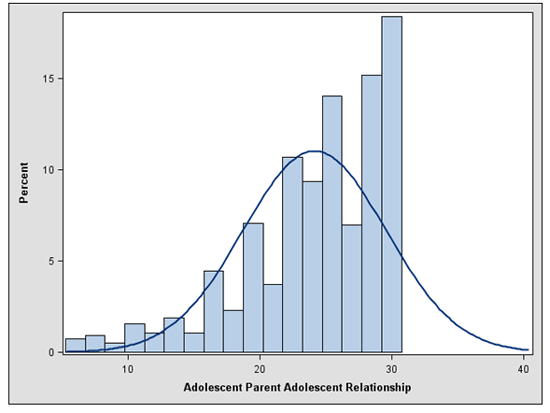Positive Relationship with Parents
Definition
The quality and types of attitudes and interactions between a parent and their adolescent, including:
-
identification with a parent
-
affective connection between adolescent and parent
-
positive interactions
-
constructive communication
Parent Scale
Please indicate how often this happens. (None of the time, A little of the time, Some of the time, Most of the time, All of the time)
-
I show my child that I am proud of him/her.
-
I take an interest in my child’s activities.
-
I listen to my child when he/she talks to me.
-
My child can count on me to be there when he/she needs me.
-
My child and I talk about the things that really matter.
-
My child is comfortable sharing his/her thoughts and feelings with me.
-
Even if my child knows I’d be disappointed, he/she can come to me for help with a problem.
Parent Scale Psychometric Properties and Fit Indices
We conducted confirmatory factor analysis (CFA) to examine whether responses to the scale appeared to measure a single construct. Along with Cronbach’s alpha, we present model fit indices below.

-
Alpha=0.86 (excellent)
-
CFI=0.994 (excellent)
-
TLI=0.986 (excellent)
-
RMSEA=0.070 (adequate)
Adolescent Scale
For each of the following statements, please tell me how often this happens. (None of the time, A little of the time, Some of the time, Most of the time, All of the time)
-
My father/mother shows me he/she is proud of me.
-
My father/mother takes an interest in my activities.
-
My father/mother listens to me when I talk to him/her.
-
I can count on my father/mother to be there when I need him/her.
-
My father/mother and I talk about the things that really matter.
-
I am comfortable sharing my thoughts and feelings with my father/mother.
Adolescent Scale Psychometric Properties and Fit Indices

-
Alpha=0.92 (excellent)
-
CFI=0.999 (excellent)
-
TLI=0.997 (excellent)
-
RMSEA=0.053 (adequate)
Subgroup Model Fit
We tested the final adolescent and parent models with subgroups to examine whether the model fit for different subsets of respondents in the same manner as the overall sample. Using the same fit statistic requirements as the overall models, a check mark indicates that the model fit for the subgroup. Household income is defined as “low” if it is less than the median income in the sample. “High” household income indicates that the household income was equal to or greater than the sample’s median.

Concurrent Validity
Four single item measures were used to examine the concurrent validity of the adolescent scale: a measure of social behavior (fighting), a measure of health behavior (smoking), a measure of emotional health (adolescent-reported depressive symptoms), and a measure of cognitive development (grades).
Concurrent validity was examined in two ways: with bivariate and multivariate analyses. The table below presents the results of multivariate analyses, which control for: teen gender, teen age, teen race, household income, household size, parental education, parental marital status, parental home ownership, parental employment, and metropolitan area and region of residence. The beta coefficient of the relationship between the construct’s scale and outcome is presented.

The graphs below show the bivariate relationships between the adolescent scale and outcomes. Results are presented for relationships that were at least moderately significant (at the 0.10 level) in the multivariate analyses. Note that the y axis scales are different in each graph.

© Copyright 2024 ChildTrendsPrivacy Statement
Newsletter SignupLinkedInThreadsYouTube